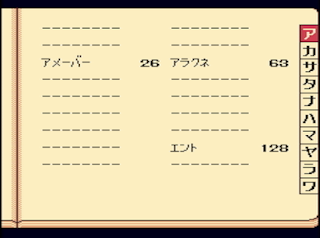Innovation of the Week: The Bestiary/Monster Encyclopedia
By alianger 1 Comments
This week, we delve into an innovation that used to be pretty rare to see within the games themselves - the Bestiary aka the Monster Encyclopedia. This innovation has proven to be more than just a collection of fantastical creatures; it can be a narrative tool, a world-building device, and a strategic resource. Furthermore, it helped games go fully digital by putting what would otherwise be in a manual or foldout into the game itself.

The concept of a Monster Encyclopedia can be traced back to the roots of tabletop role-playing games (RPGs) and the earliest computer game adaptions of them. In 1977, Gary Gygax and Dave Arneson, the pioneers behind Dungeons & Dragons (D&D), introduced the first D&D Monster Manual. It provided dungeon masters with a catalog of creatures derived from mythology and folklore, enriching the gaming experience by letting players anticipate what they would face and to define how monsters were shaped across different gaming sessions. However, the video game bestiary actually goes back to two years before this and the computer game dungeon (PDP-10, 1975), which I've covered in an earlier part of this series. Accessed from the main menu, the bestiary in this game shows single color sprites representing categories of monsters and lists what those monsters are (25 in total), then it lists their HP and EXP value on a separate page.

Paradroid & Paradroid '90 (1985/1990) - In this early action adventure/maze shooter game, players control an influence device sent out to explore and clear out a group of space ships populated by various robots that went rogue and killed the human inhabitants, before these end up in enemy hands. Using the influence device, the player can fire a weak weapon or they can engage in a unique mini-game to temporarily take over any enemy encountered, allowing them to use that robot to fight the others and giving them a second chance if they are destroyed in this form. At computer terminals found aboard each ship, a bestiary (droid database) can be found. Each robot is named with a three digit number shown on its in-game sprite, gets a more detailed picture of what it looks like, and has various other stats listed across two pages. The '90 game's bestiary features more detailed robot pictures, as seen above.

Civilization (1991) - The first game in this influential 4X (explore, expand, exploit and (optionally) exterminate) turn-based strategy series features a pretty detailed general encyclopedia called the Civilopedia, which includes information on all 28 military units (including ones with no attack like the diplomat) and can be accessed at any point during a game. These feature detailed artwork and descriptions (which also manage to have some educational value) on one screen, while a second screen shows the unit's stats, cost and technology requirements.

Aretha: The Super Famicom (1993) - In this JP only (but fan translated) RPG's monster encyclopedia, you can see an image of each monster, its basic stats, and Soul drop (these are used for crafting new equipment). Once you get it from a character called Jack near the beginning, you can open it by selecting the item in the Special Item menu.

X-COM: UFO Defense (1994) - Here's an example of using a bestiary combined with game mechanics to convey world-building and storytelling. To get a bestiary entry on an alien species, one of them must be stunned and captured in battle, then contained in a certain building and researched on using your employed scientists. Alien corpses can be researched for separate autopsy entries. The encyclopedia entry gives you a general description of an alien species' strengths, weaknesses and behavior, while autopsies provide more info on their anatomy and sometimes their origins. Research on captured alien commanders can also give access to new technology, as well as unveil the alien invaders' plans, ultimately leading to finding out how to completely stop them.

Castlevania: Symphony of the Night (1997) - Probably the game (or series) that popularized the term and concept for console games, along with Pokémon. Symphony of the Night features a massive bestiary of 130+ enemies which is accessed through the master librarian, an NPC found in Dracula's castle. It shows an enemy's stats, an image of its in-game sprite, what item(s) it can drop (after you've made it drop one of the item), and a short sentence describing it in some way. To fill it in, enemies must be encountered and either hit or killed.
---
What is your favorite memory involving a unique or memorable creature from a Bestiary or Monster Encyclopedia? Share your thoughts and experiences!
